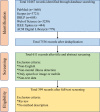Natural language processing applied to mental illness detection: a narrative review
- PMID: 35396451
- PMCID: PMC8993841
- DOI: 10.1038/s41746-022-00589-7
Natural language processing applied to mental illness detection: a narrative review
Abstract
Mental illness is highly prevalent nowadays, constituting a major cause of distress in people's life with impact on society's health and well-being. Mental illness is a complex multi-factorial disease associated with individual risk factors and a variety of socioeconomic, clinical associations. In order to capture these complex associations expressed in a wide variety of textual data, including social media posts, interviews, and clinical notes, natural language processing (NLP) methods demonstrate promising improvements to empower proactive mental healthcare and assist early diagnosis. We provide a narrative review of mental illness detection using NLP in the past decade, to understand methods, trends, challenges and future directions. A total of 399 studies from 10,467 records were included. The review reveals that there is an upward trend in mental illness detection NLP research. Deep learning methods receive more attention and perform better than traditional machine learning methods. We also provide some recommendations for future studies, including the development of novel detection methods, deep learning paradigms and interpretable models.
© 2022. The Author(s).
Conflict of interest statement
The authors declare no competing interests.
Figures





References
-
- Rehm J, Shield KD. Global burden of disease and the impact of mental and addictive disorders. Curr. Psychiatry Rep. 2019;21:1–7. - PubMed
-
- Mukherjee, S. S. et al. Natural language processing-based quantification of the mental state of psychiatric patients. Comput. Psychiatry4, 76–106 (2020).
Publication types
LinkOut - more resources
Full Text Sources
Other Literature Sources
Miscellaneous

